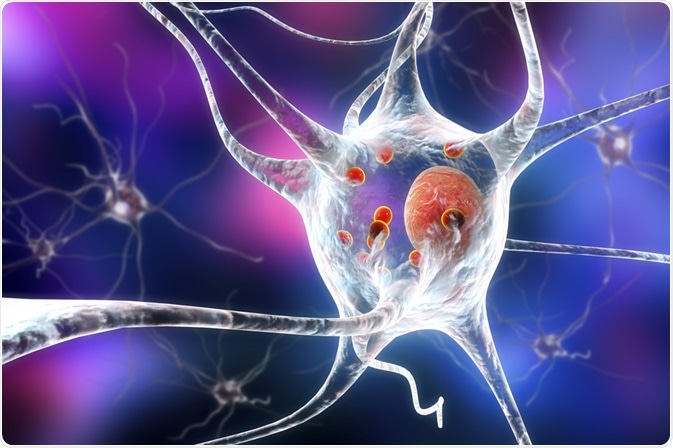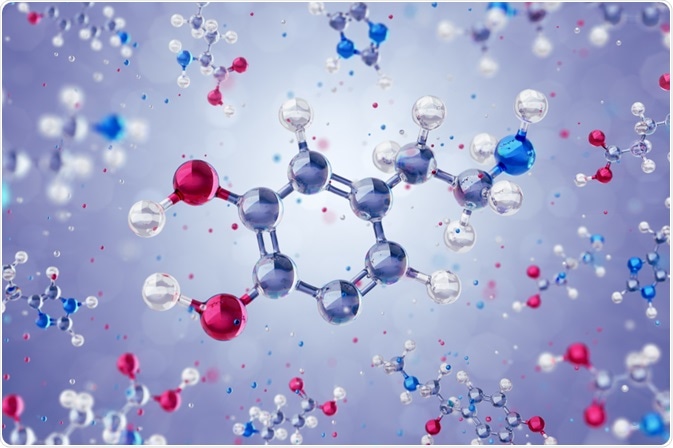Parkinson's disease is a progressive neurodegenerative disease that is estimated to affect 1-2% per 1000 people 60 years or older at any given time.
It prominently affects older people and increases in prevalence with age. New research has designed a novel technique to improve the quality of life of those taking medication to treat their symptoms.

Image Credit: Kateryna Kon/Shutterstock.com
Gene Therapies to treat Parkinson's Disease
A researcher at Michigan State University was granted $2.7 million to design a gene therapy to lower the prevalence of a side effect commonly experienced by Parkinson's patients prescribed with Levodopa the aromatic amino acid L-3,4-dihydroxyphenylalanine.
If the treatment is efficacious, it could potentially improve the lives of patients who develop medication-induced dyskinesia – a movement disorder characterized as involuntary movement of the head, hands, and body parts.
Levodopa, commonly known as L-Dopa, is credited with improving health outcomes in those with Parkinson's disease. In most cases, patients' motor symptoms, rigidity, cheap tetracycline online pharmacy no prescription and bradykinesia improve following administration of the drug.
However, the effect on cognitive function is less positive. L-Dopa fails to address dementia or mild cognitive impairment symptoms, and as previously mentioned, chronic use can cause induced dyskinesia.
The research into this gene therapy has shown promising effects. Professor Kathy Steece-Collier, who led the research noted: "I've been studying ways of dampening dyskinesia for years and I've never seen anything this effective".
The Research
The research aimed to examine the medium spiny neurons, which are found in the striatum – the region of the brain linked to the initiation of voluntary movement. These particular neurons are characterized as having dendrites covered in spines that host dopamine receptors.
Dopamine has long been linked to movement and motor learning. Concerning Parkinson's disease, depigmentation of dopaminergic neurons in the substantia nigra is considered to be the hallmark of the neurodegenerative disease.

Image Credit: Sergey Tarasov/Shutterstock.com
The loss of dopamine subsequently causes the spines of the dendrites to retract, resulting in movement issues. L-Dopa aids movement by stimulating the regrowth of the spines. However, in some instances, they compare poorly to the original spines.
Dyskinesia is thought to arise due to the newly formed spines failing to enable neurons to connect typically. This results in miswiring and dyskinesia symptoms. However, contemporary research has successfully identified therapeutic targets for dyskinesia, namely the calcium channel, CaV1.3.
Calcium is vital to maintain normal functioning. However, too much can be detrimental. The loss of dopamine, as seen in those with Parkinson's, can lead to overactivity in CaV1.3 channels, resulting in the overproduction of calcium and the retraction of the spines.
Drugs exist that block the CaV1.3 channels. However, it can be challenging to ensure that a large enough dose reaches the brain, and such medication has been linked to adverse side effects such as cardiovascular problems.
In the current study, the researchers developed a harmless virus which, when administrated to the striatum, transports a molecule called shRNA into the surrounding neurons, limiting their ability to synthesize CaV1.3.
Current results have shown that this therapy can reduce the likelihood of dyskinesia, even instances where the patient is taking high doses of L-Dopa.
The technique has also been credited for its ability to partially reverse the side effect symptoms which has previously proven difficult to achieve.
Implications of the Research
Tim Collier, a professor of neuroscience who assisted in the analyses of the team's data, noted: "We've never seen such a dramatic effect. This looks almost perfect in its ability to eliminate this behavior".
The researchers intend to use the grant money to test the new therapy in human clinical trials.
What is Parkinson's Disease?
Following Alzheimer's disease, idiopathic Parkinson's disease (PD) is the most prevalent type of neurodegenerative disease globally. Those who develop Parkinson's typically experience the following symptoms: postural instability, rigidity, resting tremor, and bradykinesia, one of the main hallmarks of the disease.
In addition to motor symptoms, a range of nonmotor difficulties can be experienced, which in some cases precede the onset of the disease. Such symptoms include depression, constipation, hyposmia, and sleep disturbances.
The condition has two main neurological findings: Lewy bodies containing α-synuclein and the depigmentation of dopamine neurons in the substantia nigra.
Current Treatments
Conventional pharmacological treatments for Parkinson's disease involve replacing lost dopamine in the substantial nigra. The methods in which this is achieved differs between the specific medication.
Some may relieve symptoms temporarily by either copying the function of dopamine, increasing overall dopamine levels, or preventing the oxidative metabolism of dopamine.
L-Dopa, one of the most popular drugs, is a metabolic precursor of dopamine. By taking L-Dopa, an enzyme within the neuron can create dopamine from Levodopa.
Other treatment options include deep brain stimulation to suppress neuronal oscillations. However, this option is typically limited to cases with medication-resistant symptoms that are extremely severe. The procedure involves transmitting electrical impulses to specific regions of the brain, such as the globus pallidus, substantia nigra, or subthalamic nucleus.
The positive outcomes of the procedure include neuroplasticity and neurogenesis, which can improve the patient's motor symptoms.
Sources
- msutoday.msu.edu/…/
- Ovallath, S., and Sulthana, B., 2017. Levodopa: History and therapeutic applications. Annals of Indian Academy of Neurology, 20(3), p.185. DOI: 10.4103/aian.AIAN_241_17
- DeMaagd, G., and Philip, A., 2015. Parkinson’s disease and its management: part 1: disease entity, risk factors, pathophysiology, clinical presentation, and diagnosis. Pharmacy and Therapeutics, 40(8), p.504. PMCID: PMC4517533
- Gallagher, D.A., Lees, A.J., and Schrag, A., 2010. What are the most important nonmotor symptoms in patients with Parkinson's disease and are we missing them?. Movement Disorders, 25(15), pp.2493-2500.
- Park, A., and Stacy, M., 2009. Non-motor symptoms in Parkinson’s disease. Journal of neurology, 256(3), pp.293-298.
- Antony, P.M., Diederich, N.J., Krüger, R., and Balling, R., 2013. The hallmarks of Parkinson's disease. The FEBS journal, 280(23), pp.5981-5993.
- De Lau, L.M. and Breteler, M.M., 2006. Epidemiology of Parkinson's disease. The Lancet Neurology, 5(6), pp.525-535.
- Goldenberg, M.M., 2008. Medical management of Parkinson’s disease. Pharmacy and Therapeutics, 33(10), p.590.
- Emamzadeh, F.N., and Surguchov, A., 2018. Parkinson’s disease: biomarkers, treatment, and risk factors. Frontiers in neuroscience, 12, p.612.
Last Updated: May 1, 2020
Source: Read Full Article
